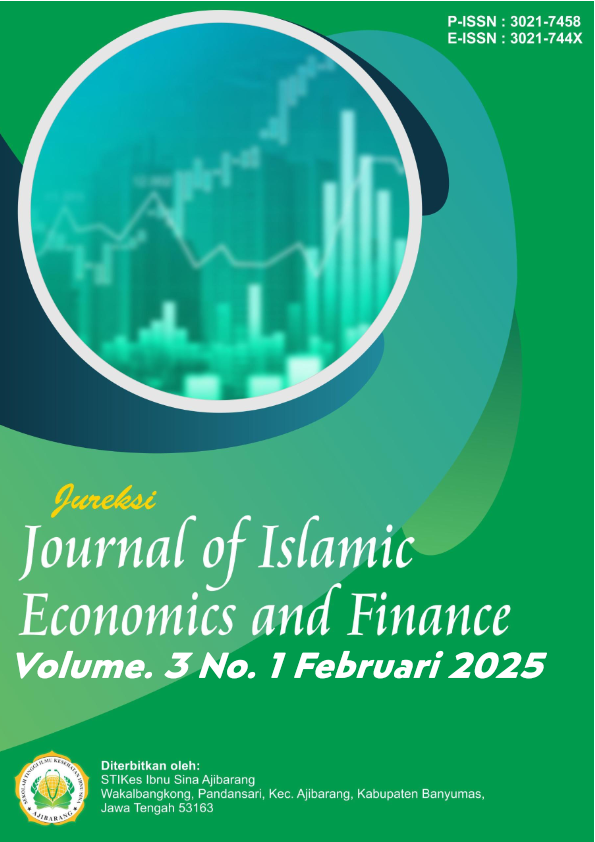Inovasi Produk Asuransi Syariah : Tinjauan Literatur terhadap Tren Pasar dan Preferensi Konsumen
DOI:
https://doi.org/10.59841/jureksi.v3i1.2341Keywords:
Sharia, Insurance, Product, Innovation, MarketAbstract
This study aims to conduct a narrative review of the Sharia insurance product innovation literature, focusing on market trends and consumer preferences. This study is intended to provide a comprehensive understanding of the current developments in the Sharia insurance industry and identify opportunities for future product innovation. This literature review uses a narrative literature review method, conducted using academic databases from leading books and articles such as Scopus, Google Scholar and Web of Science. Searches using the keywords “product innovation,” “sharia insurance or takaful,” “market trends,” and “consumer preferences” resulted in a selection of relevant articles, which were then analyzed and categorized based on the main themes of sharia insurance market trends, consumer preferences, and product innovation. The review period covers publications from 2015 to 2024 to capture the current dynamics in the industry. The review results show a significant increase in interest in sharia insurance, especially after the global financial crisis. Market trends show a steady growth in adopting Sharia insurance across countries, with increasing consumer preference for products under Islamic principles. Product innovation has evolved from traditional models such as Mudarabah and Wakalah to more sophisticated approaches, including hybrid and Waqf-based products. The study also reveals the need for more diverse products tailored to the specific needs of local markets. The review highlights the need for further research on innovative Takaful product development. Sharia Insurance companies need to focus on better understanding consumer preferences and developing products that comply with Shariah principles and offer competitive added value. In addition, there is a need to explore the integration of digital technologies in the development and distribution of Takaful products. The study provides a comprehensive view of the current landscape of product innovation in the Takaful industry, emphasising market trends and consumer preferences. The review not only fills the gap in the existing literature but also provides a foundation for future research in this emerging field.
References
Ade, E., Eriyanto, F., Mazda, N., Zenila, F., & Sania, R. (2024). Islamic insurance and conventional insurance: What’s the difference? Jurnal Sosial Ekonomi, 2(2). https://doi.org/10.31942/jse.v2i2.10134
Ahm, E. R., & Uddin, M. (2023). Development of Islamic insurance (Takaful) in Bangladesh: Legal barriers and challenges. Trabzon İlahiyat Dergisi. https://doi.org/10.33718/tid.1374161
Ahmad, W. I., & Rahman, A. B. (2011). The concept of Waqf and its application in an Islamic insurance product: The Malaysian experience. Arab Law Quarterly, 25, 203-219. https://doi.org/10.1163/157302511X553994
Ahmad, Z., Mokal, M. N., & Rahman, M. (2023). Takaful industry in the era of technological advancement. https://doi.org/10.54045/jeksyah.v3i02.726
Ahmed, M. H. (2016). Micro Takaful insurance as a tool for guaranteeing financing and protecting micro enterprises. Journal of Business and Financial Affairs, 1-11. https://doi.org/10.4172/2167-0234.1000228
Akbar, R., & Pasaribu, N. (2023). Preferensi pelanggan terhadap pasar online: Studi kasus Marketplace Shopee. El-Mal, 5(3), 1636-1659. https://doi.org/10.47467/elmal.v5i3.4772
Alshurideh, M., Alsharif, A., Alquqa, E., Hamadneh, S., Al-Hawary, S., Al-Momani, A., & Alawamleh, H. (2024). Entrepreneurial leadership: Key to sustainable innovation and competitiveness in Islamic insurance companies in Jordan.
Annie, V. (2023). The theory of consumer choice: Understanding the decision-making process. Social Science Research Network. https://doi.org/10.2139/ssrn.4508226
Anugrah, A., Samita, S., & Tenriwaru, T. (2024). Strengthening economic growth through Islamic insurance in Indonesia.
As-Salafiyah, A. (2024). Does the Covid-19 have an impact on the insurance industry? A non-parametric approach to Asuransi syariah and conventional insurance in Indonesia.
Baumeister, R. F., & Leary, M. R. (1997). Writing narrative literature reviews. Review of General Psychology, 1(3), 311-320. https://doi.org/10.1037/1089-2680.1.3.311
Behzodbek, A. (2024). Navigating the dynamics and evolution of Malaysia's flourishing takaful industry. https://doi.org/10.60078/2024-vol3-issm-pp421-422
Bossalem, A., Ghediri, D., & Serdouk, F. (2022). Evaluating the experience of the state of Qatar in the Islamic Asuransi syariah insurance industry as a pioneering model in the economies of Arab countries during the period (2013-2020).
Chetioui, Y., Bouchikhi, Y., Lebdaoui, H., Ennassiri, M., Jannah, H., Yunsi, G., Zhar, I., & Ghamas, A. (2024). Modeling the socio-economic factors affecting Islamic insurance adoption: A structural equation modeling analysis.
Doss, S. (2020). Digital disruption through data science: Embracing digital innovation in the insurance business, 20(3).
Erwin, F., Mursyid, M., & Syuhada, M. (2024). Mekanisme asuransi berbasis keuangan syariah. At-Tawazun: Jurnal Ekonomi Syariah/At-Tawazun, 12(01), 12-22. https://doi.org/10.55799/tawazun.v12i01.367.
Ferrari, R. (2015). Writing narrative style literature reviews. Medical Writing, 24(4), 230-235. https://doi.org/10.1179/2047480615Z.000000000329
Fikri, A., Azzahra, F., & Mahatmayana, I. K. M. (2024). Analisis preferensi konsumen terhadap produk beras di Pasar Baru Cikarang Kabupaten Bekasi. Paspalum, 12(2). https://doi.org/10.35138/paspalum.v12i2.740
Francesco, R., & Ruggeri, F. (2022). Teori kepuasan konsumen. https://doi.org/10.31219/osf.io/wmgyr
Furqan, M., Ramzan, M., Ullah, B., Hayat, M., Khalil, J., & Shafiq, M. (2023). Assessing the efficiency of Asuransi syariah and insurance companies in emerging markets.
Ghani, N. A., Sabri, I. I., Yaacob, S. E., Adnan, N. I., Salleh, A. D., Yakob, R., & Redzuan, H. (2019). Penggunaan dana zakat dalam pembangunan takaful mikro: Satu sorotan literatur. Journal of Fatwa Management and Research. https://doi.org/10.33102/jfatwa.vol0no0.273
Grant, M. J., & Booth, A. (2009). A typology of reviews: An analysis of 14 review types and associated methodologies. Health Information and Libraries Journal, 26(2), 91-108.
Green, B. N., Johnson, C. D., & Adams, A. (2006). Writing narrative literature reviews for peer-reviewed journals: Secrets of the trade. Journal of Chiropractic Medicine, 5(3), 101-117. https://doi.org/10.1016/S0899-3467(07)60142-6
Habibaty, D. M., & Lathif, A. (2020). Insurance waqf phenomena in the insurable interest perspective. https://doi.org/10.31330/PENAMAS.V33I2.409
Habibi, M., & Candra Yudha, A. T. (2017). Membangun integrated takaful dan wakaf model dalam upaya meningkatkan kemanfaatan pemegang polis. https://doi.org/10.26740/al-uqud.v1n2.p139-155
Hakim, U. H., & Alfat, A. F. (2023). Review of Maqashid Sharia and MUI DSN fatwa on takaful products of education funds at PT Asuransi Takaful Keluarga Yogyakarta. DIKTUM: Jurnal Syariah dan Hukum. https://doi.org/10.35905/diktum.v21i1.4606
Harahap, N. K., & Manaf Harahap, A. (2023). Wakaf polis dan sistem investasi asuransi syariah dalam perspektif hukum Islam. Yurisprudentia: Jurnal Hukum Ekonomi. https://doi.org/10.24952/yurisprudentia.v9i2.9824
Hasim, H. M. (2014). Developing a conceptual framework of microtakaful as a strategy towards poverty alleviation. Journal of Economics and Sustainable Development, 5, 1-8.
Helmy, S., Rahmawati, M., & Muhammad, W. A. (2024). Implementation of Sharia insurance in providing sustainable financial protection. Technium Sustainability, 6, 25-37. https://doi.org/10.47577/sustainability.v6i.11150
Idham, M., Razak, I. R., Yusof, M. M., Jaapar, W. E., & Ali, M. N. (2013). Acceptance determinants towards takaful products in Malaysia. https://doi.org/10.26740/al-uqud.v1n2.p139-155
Ihsan, H. L. (2024). Studi komparatif antara asuransi syariah dengan asuransi konvensional: Sejarah, sumber hukum, maysir, gharar, riba, dewan pengawas syariah, pengelolaan resiko dan premi. Yurisprudentia: Jurnal Hukum Ekonomi, 10(1), 233-251. https://doi.org/10.24952/yurisprudentia.v10i1.11618
Jesson, J., Matheson, L., dan Lacey, F. M. (2011). Doing your literature review: Traditional and systematic techniques. London: SAGE Publications.
Kahneman, D. (2011). Thinking, Fast and Slow. Farrar, Straus and Giroux.
Kamali, M. H. (2008). Maqasid al-Shariah Made Simple. International Institute of Islamic Thought.
Kotler, P., dan Keller, K. L. (2016). Marketing Management (15th ed.). Pearson.
Lestari, E., Jannah, N., Nasution, J., 2024, Effect of Service Quality and Excellence in Islamic Insurance Products on Community Preferences in Choosing an Islamic Insurance Company in Sikara Kara 1 Village, Natal Kab. Madina
Lubaba, S., Ahmad, A., Muneeza, A., 2022, Challenges Facing The Development Of Asuransi syariah Industry In Bangladesh And Indonesia: A Review
Mohamad, M., Noordin, K., Mahani, M., 2022, The Impact of Political Institutions on General Insurance/ Asuransi syariah Consumption: A Comparative Study Between OIC Countries and Non-OIC Developing Countries
Mohamed, Sherif., Sadia, Hussnain. (2017). Family Takaful in developing countries: the case of Middle East and North Africa (MENA). International Journal of Islamic and Middle Eastern Finance and Management, 10(3):371-399. doi: 10.1108/IMEFM-01-2016-0016
Mustakim, M., Mohd Zameri, S. N. S., Ngabdullah, S. K., bin Mohammad Hatta, M. F., dan Jaafar, M. N. (2023). 4youth takaful in islamic insurance industry: technology and lifestyles. Jistem Journal of Information Systems and Technology Management. https://doi.org/10.35631/jistm.833012
Nahidah, Mustafa., Fauzilah, Salleh., Asyraf, Afthanorhan., Wan, Norhayate, Wan, Daud., Ahmad, Shukri, Yazid., Norfadzilah, Rashid. (2019). A Systematic Literature Review and Meta-Analysis of Medical Health Insurance and Takaful: Evidence from Malaysia. The International Journal of Academic Research in Business and Social Sciences, 9(1):1266-1282. doi: 10.6007/IJARBSS/V9-I1/5812
Nasir, R., Rahman, A., 2022, Better Protection by Taking Travel Asuransi syariah? A Comparison in Malaysia
Nik Abdul Ghani, N.A., Muhd Adnan, N.I., Salleh, A.D., Yaacob, S.E., Yakob, R., dan Redzuan, H. (2018). Analisis Hukum Penggunaan Dana Zakat untuk Pembangunan Model Takaful Mikro. Journal of Contemporary Islamic Law. https://doi.org/10.26475/jcil.2018.3.2.04
Prahalad, C. K., dan Ramaswamy, V. (2004). The Future of Competition: Co-Creating Unique Value with Customers. Harvard Business School Press.
Puteri, Alicia, Ramadhan., Shafa, Olivia, Ananda, Fahlevi. (2023). Asuransi Dalam Perspektif Islam. doi: 10.55606/srjyappi.v1i6.788
Rifas, A., Rahman, A., Buang, A., 2023, Appraising the Universal Concepts of Insurance and Asuransi syariah: Similarities and Differences
Rogers, E. M. (2003). Diffusion of Innovations (5th ed.). New York: Free Press.
Rumaf, M., 2024, Societal Behavior Towards Islamic Insurance: A Sociological And Anthropological Perspective On Sharia Economic Law
Saharuddin, D., Mufraini, M.A., Ghoni, A., Chusna, I., Mulazid, A.S., dan Supriyono, S. (2023). Takaful funeral; an innovation for Islamic insurance product. International Journal of Islamic and Middle Eastern Finance and Management.
Saleh, B., Abida, M., 2024, Determinants of the Profitability of Commercial and Islamic Insurance Companies in Iraq: An Applied Study (Workers in Iraqi and National Insurance Companies)
Santi, Nailul, Izaty., Tsania, Umairo., Sabita, Khadiqoh., Aji, Gunawan., Rizky, Andrean. (2024). Financial management in the framework of sharia: exploring the basics of financial management based on islamic teachings. 3(01):48-68. doi: 10.62668/jisef.v3i01.1076.
Setya, Pramono., Barizatutsani, Barizatutsani., Nisrina, Ulba., W., D., L.. (2024). Application of Sharia Principles in Management Risk on Industry Insurance Sharia. 1(3):123-130. doi: 10.61132/greeninflation.v1i3.55.
Snyder, H. (2019). Literature review as a research methodology: An overview and guidelines. Journal of Business Research, 104, 333-339.
Takafultech reflects the Maqasid al-Shariah ethos in takaful (pp. 203–217). (2022). Routledge eBooks. https://doi.org/10.4324/9781003262169-14
Torraco, R. J. (2005). Writing integrative literature reviews: Guidelines and examples. Human Resource Development Review, 4(3), 356–367.
Waheed, Akhter., Saad, Ullah, Khan. (2017). Determinants of Takāful and conventional insurance demand: A regional analysis. Cogent economics dan finance, 5(1):1291150-1291150. doi: 10.1080/23322039.2017.1291150
Wilson, R. T., dan Kunkel, J. H. (2019). Consumer Behavior: Building Marketing Strategy (13th ed.). McGraw-Hill Education.
Zhang, S. (n.d.). The Impact of Digital Transformation on the Insurance Business Model and Innovative Opportunities. Financial Engineering and Risk Management. https://doi.org/10.23977/ferm.2023.061117
Zubaidi, A. (2020). Penerapan Wakaf Pada Produk Asuransi syariah. https://doi.org/10.34005/tahdzib.v3i2.893
Downloads
Published
How to Cite
Issue
Section
License
Copyright (c) 2024 Journal of Islamic Economics and Finance

This work is licensed under a Creative Commons Attribution-ShareAlike 4.0 International License.








